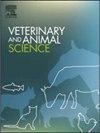Typing identification and biological characterization of Clostridium perfringens toxins associated with lamb dysentery in Xizang sheep
IF 1.9
Q2 AGRICULTURE, DAIRY & ANIMAL SCIENCE
引用次数: 0
Abstract
The objectives of this study were to investigate the etiology of morbidity and mortality in Tibetan sheep from a township in Shannan, Tibet, and to characterize the biological characteristics of the causative pathogen, thereby providing a scientific basis for effective disease prevention and control. Pathological specimens were aseptically collected from deceased animals, and the pathogen was isolated and cultured based on clinical presentations. Identification of the isolate involved morphological observation, 16S rRNA PCR amplification and sequencing, biochemical assays, toxin gene typing, Kirby-Bauer disk diffusion antimicrobial susceptibility testing, and antibiotic resistance genes screening. On tryptose sulfite cycloserine (TSC) agar, the organism formed black, circular colonies. Gram staining revealed short, straight, Gram-positive bacilli arranged singly or in pairs, consistent with the Clostridium perfringens . 16S rRNA gene sequence alignment showed >99 % identity to reference C. perfringens sequences in the NCBI database.
Confirming the strain asC. perfringens. Biochemical tests indicated positive reactions for glucose, Biochemical assays were positive for glucose, lactose, and maltose fermentation; gelatin hydrolysis; oxidase activity; nitrate reduction;hydrogen sulfide production; and ornithine decarboxylase, but negative results for indole production, mannitol and sorbitol fermentation, and urea hydrolysis, matching known traits of C. perfringens. . Toxin gene PCR detected cpa,cpb, and etx, but not iap, cpe, or netB, identifying the isolate as C. perfringens type B. Antimicrobial susceptibility testing revealed high sensitivity to sulfadiazine, norfloxacin, nitrofurantoin, and cefazolin, but resistance to amoxicillin, oxacillin, carbenicillin, and tetracycline.Among the resistance genes screened, only aac(6′)-Ib-cr was detected.This study reports the first isolation of C. perfringens type B in Shannan, Tibet; elucidates its biological characteristics and toxin profile; identifies effective antibiotics for targeted intervention; and provides foundational data for controlling lamb dysentery caused by this pathogen and for understanding its pathogenicity in sheep.
西藏羊羊痢产气荚膜梭菌毒素分型、鉴定及生物学特性研究
无菌采集死亡动物病理标本,根据临床表现分离培养病原菌。鉴定包括形态学观察、16S rRNA PCR扩增和测序、生化分析、毒素基因分型、Kirby-Bauer盘片扩散药敏试验和抗生素耐药基因筛选。在胰蛋白酶亚硫酸盐环丝氨酸(TSC)琼脂上,微生物形成黑色的圆形菌落。革兰氏染色显示革兰氏阳性杆菌短而直,单或成对排列,与产气荚膜梭菌一致。16S rRNA基因序列与NCBI数据库中产气荚膜荚膜菌参考序列的一致性为99%。确认菌株为asC。perfringens。生化试验表明葡萄糖呈阳性反应,生化试验表明葡萄糖、乳糖和麦芽糖发酵呈阳性反应;明胶水解;氧化酶活动;硝酸盐还原;硫化氢生产;在产吲哚、甘露醇和山梨醇发酵、尿素水解等方面均呈阴性,与已知产气荚膜荚膜菌的性状相符。毒素基因PCR检测到cpa、cpb和etx,但未检测到iap、cpe和netB,鉴定该分离物为产气荚膜杆菌b型。药敏试验显示,该分离物对磺胺嘧啶、诺氟沙星、呋喃托因和头孢唑林敏感,对阿莫西林、恶西林、卡比西林和四环素耐药。在筛选的耐药基因中,仅检测到aac(6’)-Ib-cr。本文首次报道了C。
本文章由计算机程序翻译,如有差异,请以英文原文为准。
求助全文
约1分钟内获得全文
求助全文
来源期刊

Veterinary and Animal Science
Veterinary-Veterinary (all)
CiteScore
3.50
自引率
0.00%
发文量
43
审稿时长
47 days
 求助内容:
求助内容: 应助结果提醒方式:
应助结果提醒方式:


